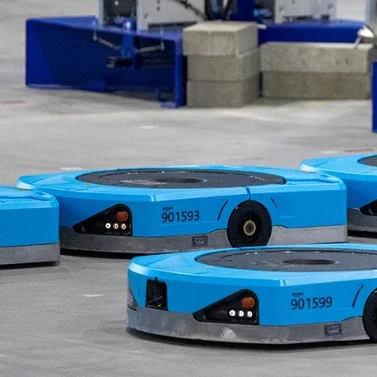Amazon has been using robots to manage and automate their warehouses for years. Here’s a short feature on their current robot, Hercules. This is absolutely Amazon tooting their own horn, but if you have been curious about what exactly such robots do, and how exactly they help a busy warehouse work better, it’s a good summary with some technical details.

The main idea is that goods are stored on four-sided shelves called pods. Hercules can scoot underneath to lift and move these pods a little like a robotic forklift, except much smaller and more nimble. Interestingly, the robots avoid rotating shelves as much as possible and are designed to facilitate this. To change direction, Hercules sets the pod down, turns, then picks the pod back up.
The overall system is centralized, but Hercules itself navigates autonomously thanks to a depth-sensing camera and a grid of navigation markers present on the floor throughout the facility. Hercules also can wirelessly sense and communicate with nearby human-worn vests and other robots outside its line of sight.
Essentially, instead of human workers walking up and down aisles of shelves to pick products, the product shelves come to the humans. This means the organization and layout of the shelves themselves can be dynamic, higher density, and optimized for efficient robotic access. Shelves do not need to be in fixed rows or aisles, conform to a human-readable categorical layout, nor do they necessarily need walking space between them.
Sometimes robots really are the right tool for the job, and our favorite product-retrieval robot remains [Cliff Stoll]’s crawlspace warehouse bot, a diminutive device made to access boxes of product — in [Cliff]’s case, Klein bottles — stored in an otherwise quite claustrophobic crawlspace.
















This looks very much like the method Ocado use in the UK:
https://www.youtube.com/watch?v=ssZ_8cqfBlE&t=2s
Getting a lot of robot warehouse content, pretty cool.
How do the Ocado robots access the totes that are deeper in? Do they pop the stack into a relatively empty pile until they find what they want?
As for the article, the Amazon system with the shelves… I wonder how that works (more in-depth). Seems like they can’t manipulate the pods they lift. I’m assuming there is a secondary and tertiary system that is human or automated in nature but not shown.
In the more generic case, we call them AMR – Autonomous Mobile Robots. There are somewhat generic models produced by different makes, that you do adapt to your application, both hardware- and software-wise. For example you might build it into some larger trolley with some specific equipment for loading / unloading workpices / pallets or what it is used for.
The ‘file system’ was modeled after a human warehouse. Then the ‘file system’ evolved. And the human warehouse became modeled after the ‘file system’. :)
the same happened here in The Netherlands with homes: showrooms tried to look like homes, now homes try to look like showrooms
“To change direction, Hercules sets the pod down, turns, then picks the pod back up.”
If Donald were to watch the gif/video in the linked article, he’d have seen this is not the case.
Amazon/Kiva’s robots turn underneath the pod without setting it down. The top platen is on bearings, like a Lazy Susan, so the pod doesn’t rotate with the bot. Setting the pod down every time the bots had to make a turn on a busy warehouse floor would be enormously inefficient.
Yes, the Ocado robots pop the stack one by one to access the lower totes. The planning system obviously knows where everything is and is able to optimise movements, although shallower movements are preferred at all times.
I used to work on the Ocado robots.